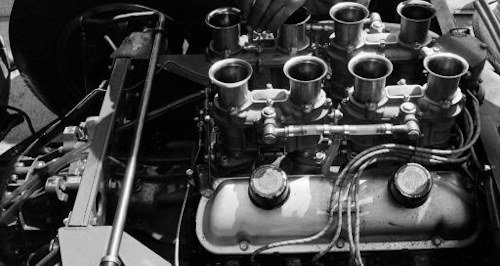Lola Mk6 GT
 |
|
|
Class |
Race car |
|
Constructor |
Lola Cars |
|
Body |
2 door GT Prototype |
|
Designer(s) |
Eric Broadley (chassis)John Frayling (coachwork) |
|
Successor |
Ford GT40 |
|
Chassis |
Aluminium monocoque (steel monocoque for prototype car) |
|
Suspension |
Double wishbones |
|
Length |
3,912 mm (154.0 in) |
|
Width |
1,600 mm (63.0 in) |
|
Height |
1,016 mm (40.0 in) |
|
Wheelbase |
92.13 in, 2340 mm |
|
Track |
F-R 51.97 in, 1320 mm |
|
Engine |
Ford Motor Company, 289 cu in (4.74 l) |
|
Transmission |
Colotti Tipo 37 4 speed manual |
|
Weight |
steel 950 kg (2,094.4 lb) Aluminium 1323 1b, 600 kg |
The Lola Mk6 GT was a Prototype racing car with a production run of only three units built between 1962 and 1963
History
The Lola Mk6 GT built by British car manufacturer Lola Cars. With its the mid-engine V8 289 cu in (4.74 l) Ford engine, the Mk6 GT was the first mid-mounted, high displacement V8-powered Grand Touring car, a chassis arrangement that had been used, up until that time, only on formula cars and smaller, more affordable GTs.
The Lola Mk6 GT was conceived by Eric Broadley at the end of 1962 to be accepted into the Experimental Grand Touring class. For GT Manufacturers for the 1962 season, in order to have mid-engine GT cars they need to make their way into production. But the Experimental Grand Touring cars later known as Prototypes, now had minimum production requirement, but still requiring roadworthiness.it was difficult for mid-engine cars to handle torque provided by big V8 engines. With a Colotti Tipo 37 gearbox transaxle gearbox capable of managing the enormous torque provided by big V8 engines. The coachwork fiberglass body was designed by John Frayling and made by FRP, came with roof engine air intake and special doors which extended into the roof to give the drivers greater access.

The Mk6 GT featured some innovated technology of the time such as an aluminium monocoque. The Ford-Colotti engine-gearbox assembly was a stressed member and the rear suspension was mounted directly on it. As a result, the car was so compact that the wheelbase was even shorter than Lola's other formula cars, despite using a large 400 hp V8 engine.
The prototype car (chassis LGT-P, steel monocoque) was shown by Broadley to the public in January 1963 at the UK Olympia Racing Car Show, While LGT-P was being raced, a second car (chassis LGT-1, aluminium monocoque) was being completed and prepared for the 1963 24 Hours of Le Mans. The 1963 Ford V8 Mk6 (Lola GT) sports car with fiberglass components put in a good showing at the 24 Hours of Le Mans with David Hobbs. Broadley was drawn to Ford by the performance of the Lola sports cars and hired him as a technical consultant on the GT40 project. However, Broadley left Ford again after 18 months because he did not want to give up the independent work he was used to. Understanding the potential performance of the Mk6, the Ford Motor Company bought it so as to further test its capabilities, laying the foundation for its GT40 project.
Technical
-
Lola Mk6 GT Technical details and specifications (1962-1963)
ENGINE:
Ford Mid engine V8
capacity 260.66 cu in, 4262 cu cmTRANSMISSION DRIVE LINE :
4 or 5-speed gearbox with rapid change of ratios.CHASSIS:
Aluminium monocoque (steel monocoque for prototype car)
Chassis integral at centre and rear, tubular trellis at front
wishbones suspensionBRAKES:
Disc brakesDIMENSIONS AND WEIGHT:
Wheel base 92.13 in, 2340 mm
front track 51.97 in, 1320 mm
rear track 51.97 in, 1320 mm
overall lenght 153.54 in, 3900 mm
overall widht 61.81 in, 1570 mm
overall height 39.37 in, 1000 mm
dry weight 1323 1b, 600 kg© Motor car History
